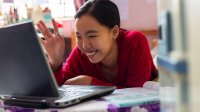3 Ways to Build Relationships—in Person or Virtually
These approaches help build trust and a sense of community in middle and high school, no matter where or how classes are held.
Establishing strong teacher-student relationships is key to educational success—whether we instruct our students in real time or remotely. Strong relationships provide students with a sense of support and the knowledge that we care. They are also part of culturally responsive teaching, which fosters increased engagement and learning outcomes among racially and culturally diverse students. In her book Culturally Responsive Teaching and the Brain, Zaretta Hammond describes teacher-student relationships as “learning partnerships” that build on mutual trust and authentic connections.
As Hammond points out, caring is how we can generate trust. Teachers can demonstrate caring by asking students about their personal interests and strengths and areas for improvement—and then providing specific feedback so that students can grow.
“Two Truths and a Lie”
This activity has worked well as a getting-to-know-you activity in my ninth-grade advisory groups. Students write three “facts” about themselves on an index card: two truths and a lie. Seated in a circle, they take turns sharing the information on their cards. Students guess which “fact” is the lie before the author reveals the answer, elaborating on any truth or lie they choose. Other students may ask follow-up questions.
If the activity is offered remotely, students can email their two truths and a lie to the teacher, indicating which is the lie. Using Kahoot or another program, the teacher can create a virtual version of the game. Each student’s two truths and a lie become a Kahoot question. The teacher identifies the lie as the “correct” Kahoot answer.
At the designated time during remote learning, the teacher’s screen can be shared through Zoom, and students can log into Kahoot. Through Zoom’s audio, students have a chance to elaborate about the lie (or their truths). Using this activity at the beginning of the school year establishes foundational connections for the whole year.
Individual Conferences and Goal Setting
I found that after this spring’s move to remote learning, many of my students became more aware of their strengths and any areas where they felt they needed additional support. In June, I asked students about their remote-learning experiences. Many said that they wished they’d had more time-management skills and had been more organized prior to remote learning.
Upon their return to the classroom this fall, students might identify at least one strength and one improvement area. Each student might establish an individualized goal based on their self-perception. Goals should be academically important and meaningful to the student. These goals can be revisited midyear and at the end of the year.
During in-person teaching, teachers might confer with students individually, holding a conference of five to seven minutes. The conference might begin with students’ self-identifying a strength and an improvement area. At the beginning of the year, students would benefit from identifying a goal that could be accomplished quickly, and/or one that would support other required skills.
Teachers can then discuss concrete steps needed to achieve the goal. I plan to document each student’s information on a separate index card so that I can refer to their progress and provide specific feedback throughout the year. This process can allow students to feel a sense of accomplishment and success as they progress toward mastery.
To confer remotely, teachers can create one Zoom session and ask students to sign up for specific conference times using SignUpGenius or Google Calendar. Within Zoom, enabling the waiting-room feature ensures that students won’t accidentally enter another student’s conference. Engaging with their teachers in one-on-one conversations about strengths and discussing specific steps to achieve their self-selected goals helps students feel that their teachers care about them—which builds trust.
Get Students’ Input
For the past two years, I’ve collected my ninth-grade students’ input on content and other instructional approaches I use, including brain breaks, community circles, and the like. Getting students’ input provides me with vital feedback about how activities are perceived, which I then use to adjust instruction. It also enables students’ voices to be heard.
In person, teachers can gather student input through community circles, jigsaw activities, or entrance and exit slips. In a virtual classroom, students can provide input through a form, in a virtual class conversation, in a Kahoot game, or by email. Providing opportunities for students’ voices to be heard helps students feel valued, which further builds stronger student-teacher relationships.
